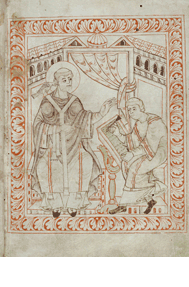THE WORKS OF GREGORY THE GREAT
|
Exegetical writings. Writings devoted to commentary on the Bible constitute the largest part of Gregory’s imposing corpus of literary work. The Moralia in Iob, a commentary on the Book of Job in 35 books, is a sort of encyclopaedia of Christian life, in which the author, moving away from the Biblical text, addresses a wide range of themes relating to Christian behaviour. The Expositio in Cantica canticorum and the Expositio in librum primum Regum, devoted respectively to the books of the Song of Songs and the first book of the Book of Kings, like the Moralia, focus on thorough commentary of the books of the Bible. The forty homilies on the Gospels (Homiliae in Evangelia) and twenty-two homilies on the Prophet Ezechiel (Homiliae in Hiezechihelem prophetam) are what remain of the intense preaching Gregory considered his major duty as bishop. While the former were apparently destined to a popular audience - to the general congregation of faithful present in church to hear the work of their pastor, the latter most likely presuppose a more select public made up of monks and ecclesiastics. The Regula pastoralis. With the Regula Gregory has composed a treatise on the art of preaching, on the responsibilities of a shepherd of souls. Each of its four parts examines an aspect of this difficult duty: how to prepare, how to act, how to teach others, how to recognise one’s limits with humility and prevent becoming overwhelmed by pride. The Dialogi. The Dialoghi narrate in four books the miracles performed by Italian saints during the reign of Totila the Goth and the Longobard invasion. The protagonists of the first book are twelve saints, of the third book over thirty. The second book is devoted entirely to St. Benedict of Norcia, while in the fourth book the tale of miracles reveals the fate of souls in the afterlife. From a literary point of view, the Dialoghi are Gregory’s masterpiece. The Registrum epistolarum. We have Gregory’s epistolary in 14 books, one for each year of his pontificate. Counting more than 800 letters, they constitute a collection of extraordinary importance for understanding the history of his time and chronicling in detail his work as pontiff.
|


